Kohl
The allure of the East was a growing influence in Western art and literature in the nineteenth century. The Arabian Nights and other oriental stories conjured up images of harems, flying carpets, deserts and exotic Middle Eastern cities. Veiled women with kohl blackened eyes were included in Western ideas of the mysterious East and Western stage and screen players often blackened their eyes to make them look exotic. In the early twentieth century, this effect was used by the Russian dancers of Diaghilev’s Ballets Russes and silent movie ‘Vamps’ like Theda Bara and Pola Negri.
Eye blackeners
Kohl had been introduced into Europe in the eighteenth century but eyelash and eyebrow blackeners had been made in Europe from soot well before that, with numerous recipes in circulation.
To Blacken the Eye-lashes and Eye-brows.
The simplest preparations for this purpose are the juice of elder-berries; burnt cork, or cloves burnt at the candle. Some employ the black of frankincense, resin, and mastic: this black, it is said, will not come off with perspiration.
Black Composition for the same. Take an ounce of pitch, the same quantity of resin and frankincense, and half an ounce of mastic. Throw them upon live charcoal, over which lay a plate to receive the smoke. A black soot will adhere to the plate; with this soot impregnate the eye-lashes and eye-brows, by rubbing them with it very delicately.
This operation, if occasionally repeated, will preserve them perfectly black.
OBS. The above composition may be perfumed with a little of the oil of Benjamin, eau de Cologne, or a little of the juice of elder-berries, and it is fit for being applied to the eye-brows or eye-lashes.(The toilette of health, beauty, and fashion, 1834)
Powdered kohl
In its simplest form, kohl is a fine, black or dark grey powder. In the past, better-quality kohl was made by grinding up galena (lead sulphide) or stibnite (antimony sulphide) – both poisons – but it could also made from carbon black or iron oxide – which are harmless. Kohl is therefore a chemically diverse material, defined more by its colour and use than by its composition. In Europe, this diversity was magnified by the tendency to call any black eyebrow or eyelash cosmetic a kohl, even those made from materials such as ink – a situation that lasted up to the Second World War.
The kohl or black eyebrow cosmetic is variously prepared. The spirituous: Iampblack 140 is finely divided in simple tincture of benzoin (20 per cent. strength) 210, and there are added 12.5 of gum lac dissolved in 630 of alcohol, 5 of castor oil, and 2.5 of rose synthetic extra or other perfume as desired. The ordinary Liquid Kohl is made from (a) lampblack, ivory black, or drop black 10, with powdered gum acacia 10, rubbed out thoroughly with 80 of rose water or orange flower water; or (b) the acacia in the last example is replaced by 2 of powdered tragacanth rubbed down with 10 of perfumed spirit. Continental forms of kohl are prepared from Chinese or Indian ink, as (a) Indian ink powder 10, powdered gum acacia 1, and orange flower water to 100; or (b) Indian ink liquid 64, glycerine 15, gum acacia 1 in rose water 5, and perfumed spirit 15. Paste forms of kohl are prepared from about 8 of one of the fine blacks, rubbed out fine with 1 of hard and 11 of soft paraffin previously melted.
(Eye Cosmetics, 1932)
Using powdered kohl
In the East, powdered kohl is a traditional eyeliner and eyeshadow but usually applied differently to how these products are used in the West. In the European tradition it is more common to line the outside of the eyelashes – above the upper lashes and below the lower ones. In the East powdered kohl can be smudged around the eye but it is also applied on inner surface of the eyelid – known as the conjunctiva, inner rim or waterline.
Applying kohl on the waterline involves dipping a rod-like applicator into kohl powder and then, after flicking off the excess, passing the rod through the base of the lashes while the eyes are closed. If done correctly, the wet conjunctiva picks up the powder from the side of the rod creating a smooth, even line. Any spots that are missed can then be lightly touched up with more powder using the pointed end of the applicator.

Above: Applying powdered kohl to the conjunctiva (waterline).
Dorin recommended something similar when applying El Mesdjem, a kohl they were selling in the late nineteenth century.
Enduisez la flèche de MESDJEM et placez-la horizontalement entre les paupières sur la longueur de l’œil, fermez l’œil sur la flèche et faites glisser enire les paupières en tournant légèrement. Ensuite, avec un linge fin, essuyez les yeux et au besoin lavez à grande eau, ce qui.
Trans: Coat the wand with MESDJEM and place it horizontally between the eyelids along the length of the eye, close the eye on the wand and slide it between the eyelids by turning slightly. Then, with a fine cloth, wipe the eyes and, if necessary, wash with plenty of water which can only add to the beauty of the look.(Dorin catalogue, 1893)
Paste kohl
In the East, powdered kohl was also made into a paste by mixing it with fats and oils. The paste was traditionally applied on the eyebrows and around the eyes so was equivalent to Western eyeshadows, eyeliners or mascaras. It is possible that this is what some of the Ballets Russes dancers and silent screen Vamps used but it is hard to be sure. Given the wide variety of eye blackeners that were available – including greasepaint liners, Indian or Chinese ink mixed into glycerol, lampblack incorporated into a fat or gum, and mascaro/water cosmetique – and the tendency to call any black eyebrow or eyelash cosmetic a kohl, it is difficult to be certain about the cosmetics they employed. It seems likely that more than one cosmetic was used to achieve the effect they were after and traditional kohl may not have been used at all. Helena Rubinstein – who claims to have been responsible for Theda Bara’s eye make-up – makes no mention of it.
For Theda Bara, the Siren of the Silent Screen, we helped to create ‘The Vamp’ look which became internationally famous. Enthusiastic fans copied her hairstyles, her clothes, and her mannerisms. Her eyes were amazingly beautiful, but camera techniques were not as advanced as they are now and much of her beauty was lost on the screen. She came to me to find a way of emphasizing them.
Eye make-up of any kind was unknown in America. Mascara had been used only in France by a few stage personalities, and not always well. But with my love for the theatre and my insatiable curiosity, I had delved into the beauty secrets of several French actresses. I had also experimented with kohl (the eye make-up invented by the ancient Egyptians and used by Cleopatra). For Theda Bara I made a mascara which drew attention to her lovely eyes so that they dominated her whole face—and the mascara did not streak! I also added a touch of colour to her eyelids. The effect was tremendously dramatic. It was a sensation reported in every newspaper and magazine—only a little less of a sensation than when Theda Bara first silvered her eyelids!(Rubinstein, 1965)
See also: Eye Shadow
Rubinstein, Arden and kohl
The kohl Rubinstein mentioned above was a reference to the Egyptian Kohol Jet Grains she added to her make-up range in 1907. This powdered cosmetic came in a bottle and used an ivory stick (‘Merueud’) to apply the powder grains to the eyelashes and eyelids. Rubinstein abandoned the product sometime after the First World War.
See also: Helena Rubinstein
Elizabeth Arden also introduced a product that was like a traditional kohl but did so much later in 1955. The superfine powder, which came in shades of brown, blue, grey-black and green, was packaged in little glass flacons shaped like a miniature urn complete with a tiny wand applicator. The wand could have been used to apply the kohl to the waterline of the eye but suggestions are that it was used primarily to darken the area around the eye, something more easily achieved with eyeliner or eyeshadow. The product was not a great commercial success and advertising for it drops off rapidly after 1956.
In France … where beautiful makeup is an art called “Maquillage” … the Elizabeth Arden Salon is famous for the talented staff who specialize in this delicate skill. Now, a new Eye Makeup created by Miss Arden … based on an ancient secret of the long-eyed queens of the Far East, Nicolet will show you how to outline your eyes delicately with Kohl-Arabia … a superfine powder applied with a tiny wand … how to draw and arch your brows and he’ll complete this new Oriental Makeup with Pure Gold Eye Shado or Shimmering Silver … Don’t Miss It.
(Elizabeth Arden advertisement, 1955)
See also: Elizabeth Arden (post 1945)
Later use in the West
Films like Cleopatra (20th Century Fox, 1963) generated a renewed interest in heavy eye make-up in the 1960s – in the same way that the Ballets Russes and Vamps had done years before – but most people made up their ‘Cleopatra eyes’ with standard eyeliners and eyeshadows. If traditional kohl was used, it was only rarely applied along the waterline of the eye.
In the 1970s, the Middle Eastern oil crisis and a rising interest in ‘traditional’ and ‘natural’ make-up, saw references to kohl appear once again in beauty articles but this usually occurred without much reference to application techniques so the products were largely kohl in name only.
Current usage
Looking back it is easy to see why traditional forms of kohl never achieved the widespread use in the West that they enjoyed in the East:
Colour: Western complexions are generally lighter than those in the East. Black kohl suits certain skin colourings but could not hope to match the myriad of colours and colour styles found in Western eyeliners, eyeshadows and mascaras.
Medical: In the East kohl was believed to improve eyesight and protect the eyes from infection, views that were not common in the West.
Technologies: The pencil was a Western invention. Eyeliner and eyebrow pencils made applying eye make-up relatively simple, cheap to make, and could be safely carried around in a purse. Powdered kohl requires more skill to apply, costs more to package in a bottle, has the potential to spill, and requires a separate applicator that can be easily misplaced.
The introduction of Western cosmetics into those parts of the world where kohl was traditionally used has affected developments there as well. Products sold as kohl in the Middle East are now found in a wide variety of colours and can be bought in powder, cream and pencil forms. Many of these current day products are therefore ‘kohl’ in name only and are essentially the same as cosmetics used in the West, making many modern kohls synonymous with mascara.
Although a few companies like Guerlain have introduced traditional powdered kohl into their product lines it would seem that this eye cosmetic will remain on the margins for most Western users. This was particularly so after the introduction of modern-day Eye Markers made the application of dramatic eye make-up very easy.
See also: Water cosmetique (Mascaro) and Cake Mascara
First Posted: 30th August 2012
Last update: 2nd July 2024
Sources
Cartwright-Jones, C. (2005). Introduction to Harquus: Part 2: Kohl as traditional women’ s adornment in North Africa and the Middle East.TapDancing Lizard Publications.
Eye cosmetics. (1932). Perfumery and Essential Oil Record. November, 373-374.
Kempson-Jones, G. (1947). Mascara: A simply prepared cosmetic. Manufacturing Chemist and Manufacturing Perfumer. XVIII(2). 73-74.
Poucher, W. A. (1932). Perfumes, cosmetics and soaps (4th ed., Vols. 1-2). London: Chapman and Hall Ltd.
Rubinstein, H. (1965). My life for beauty. Sydney: Bodley Head.
Sagarin, E. (Ed.). (1957). Cosmetics: Science and technology. New York: Interscience Publishers, Inc.
The toilette of health, beauty, and fashion. (1834). Boston: Allen and Ticknor.
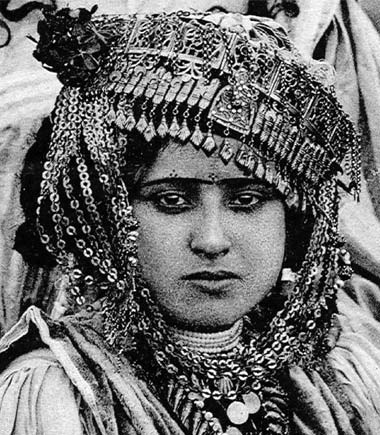
Kohl as used in a traditional setting (Cartwright-Jones, 2005). The woman seems to be using it to darken her eyebrows and the area around the eye but her waterline appears to be clear. This suggests she was using paste rather than powder kohl.

A modern day application of kohl on a man using the traditional technique. The kohl stick would be dipped in powder before being dragged across the waterline of the eye.

1893 Dorin El Mesdjem (France).

Dancers from Diaghilev’s Ballets Russes showing a range of eye make-up. Close examination of the photographs of these dancers indicates that some appeared to be applying kohl along the waterline of the eye while others were not.
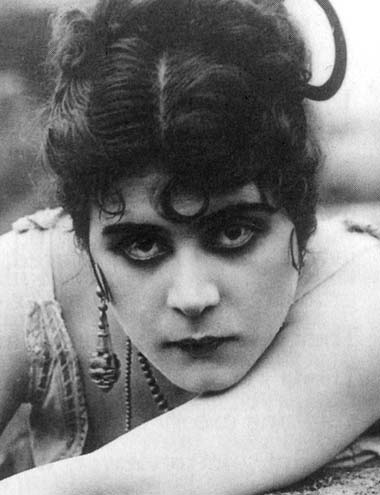
Theda Bara [1885-1955]. Although her eyebrows and the area around her eyes are dark, the waterline of her eye is clear. This suggests that she was not using powdered kohl or was only using it around her eyes.
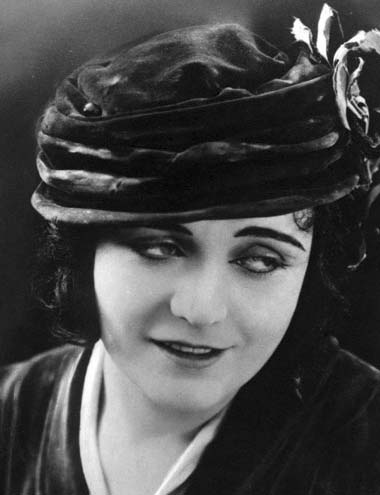
Pola Negri [1897-1987]. As well as darkening her eyelids and eyebrows, Negri has drawn a hard line around her eyes to make them appear larger than they are. The dark line in the eyelid fold suggests that her eyeshadow was grease-based. Like Theda Bara her waterline is clear.
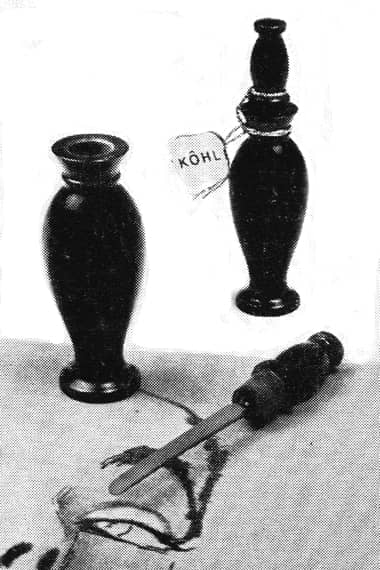
1955 Elizabeth Arden Kôhl bottles and applicator.

1955 Elizabeth Arden eye make-up (London)
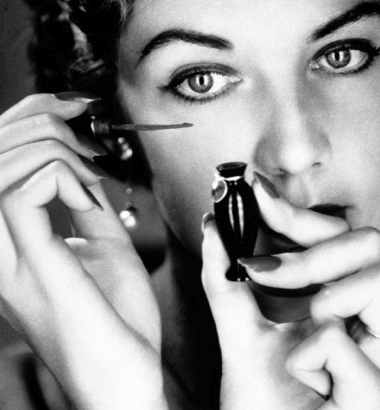
1955 Publicity shot for Elizabeth Arden’s Kôhl-Arabia Oriental Eye Make Up. It is being applied around the eye and not along the waterline. Most people would find this easier to do with an eyeliner. In the United States, Arden used her make-up artist, Guy Nicolet from Paris, to demonstrate how it was to be used.

1963 Elizabeth Taylor’s eyes in the film Cleopatra heavily made up to look exotic but not applied along the waterline.

1976 ‘Kohl’ eye make-up affect being achieved with eyeliner, mascara and smudging kohl powder around the eye. “For daytime, use green or blue kohl. Draw a pencil line close to the lashes all around the eye. Smudge this line, especially at the outer edges. It must not look like eyeliner. Now colour the eyelid with kohl powder and smudge it upward towards the eyebrow. Let it fade out toward the brow. Bring the powder around the outer corners of the eye and along the lower lid a fraction. Now use masses of mascara.
For night time, use black kohl. Draw a pencil line around the eye to outline. Smudge the powder along the eyelid and upward toward the brow. Using a pencil again, draw a line along the inside rim of the upper and lower lids. Fade the whole shape out toward the outer eye corner to make a long eye (Australian Women’s Weekly, 1976).
